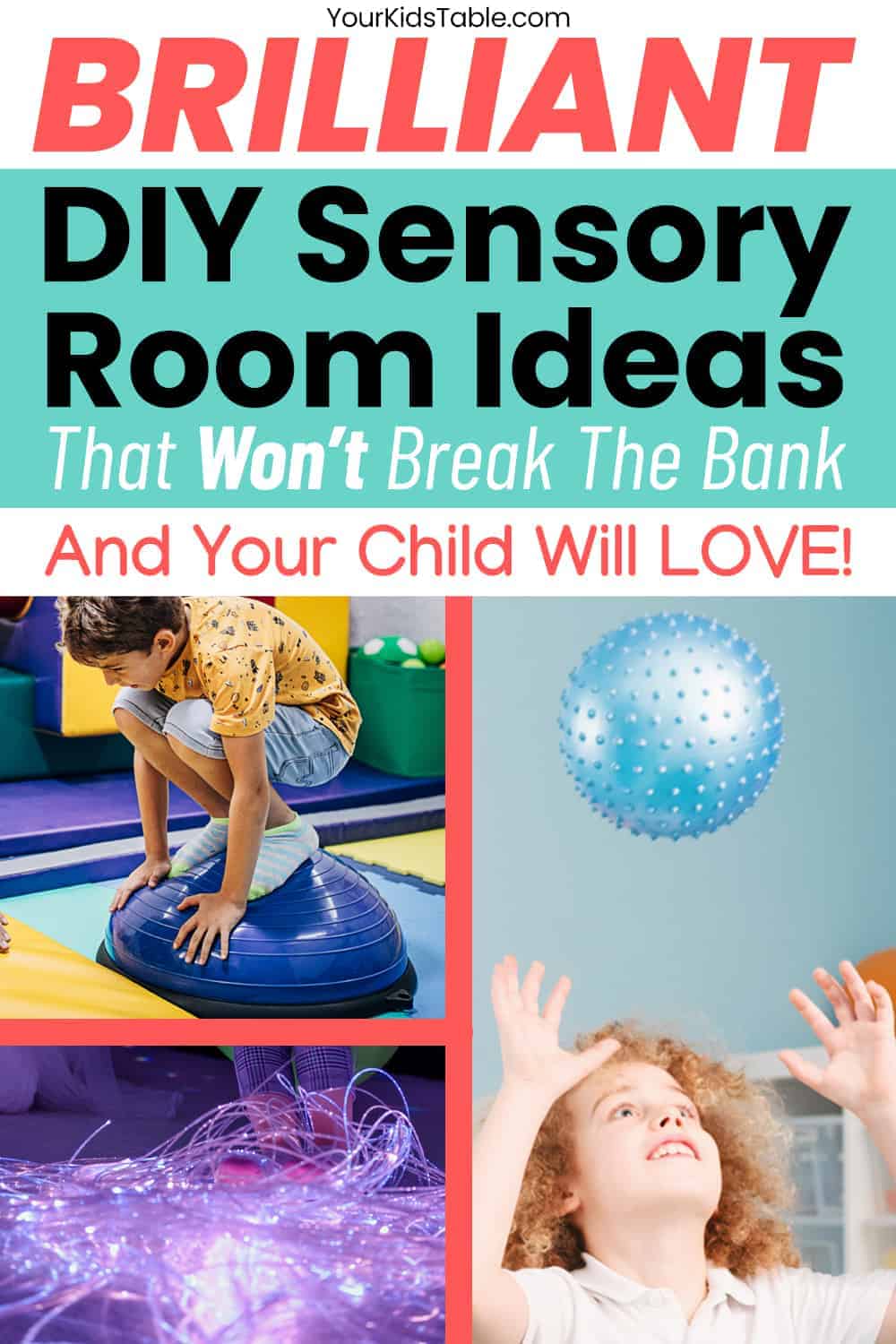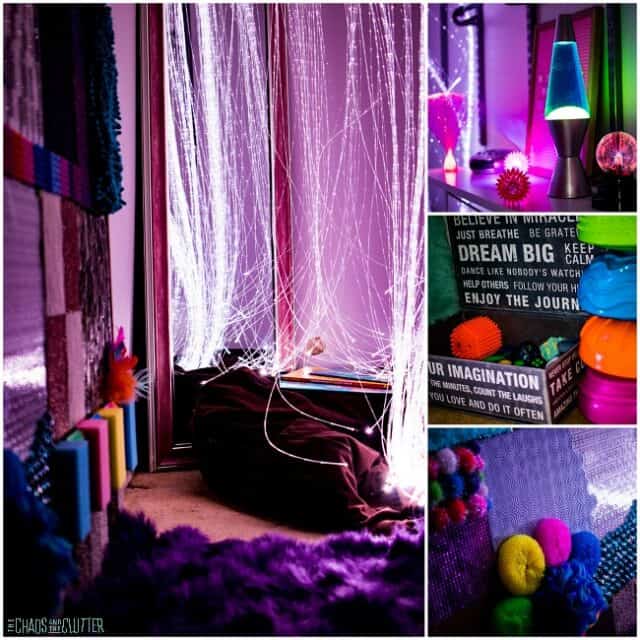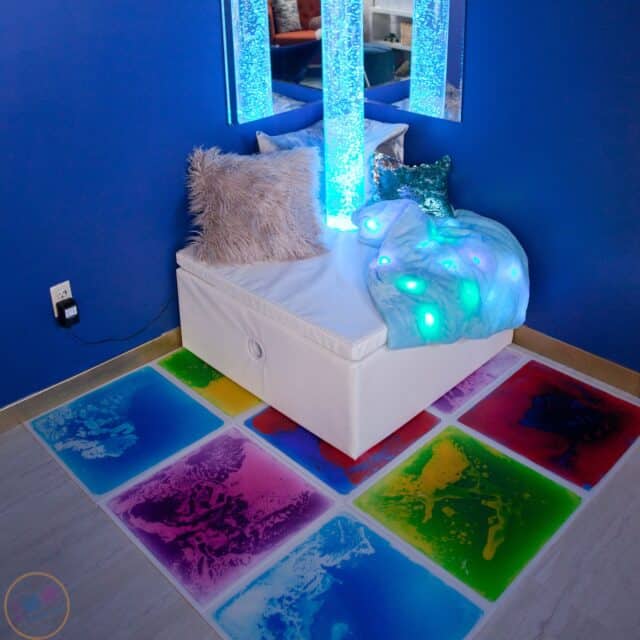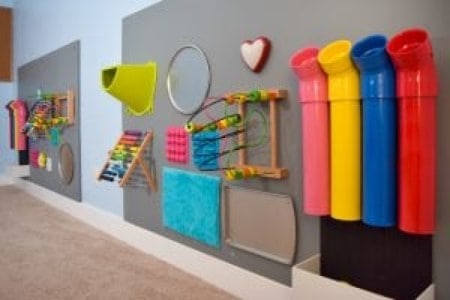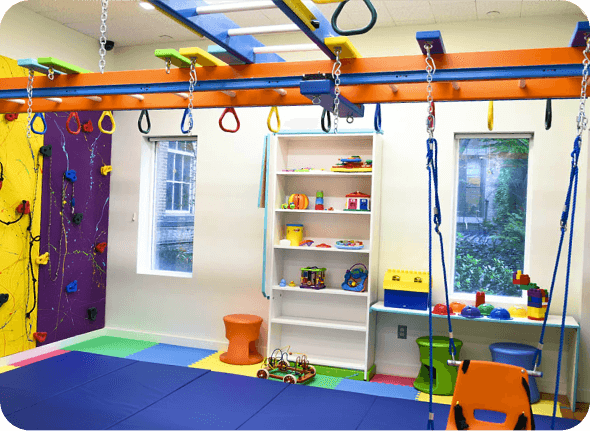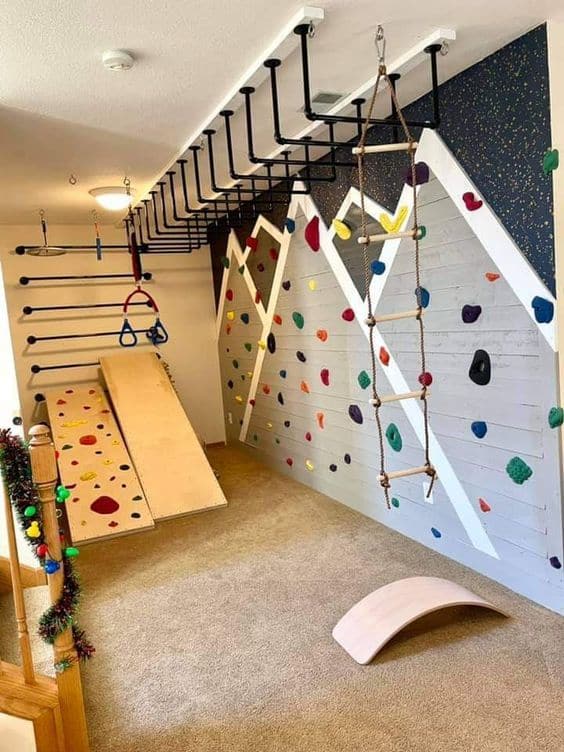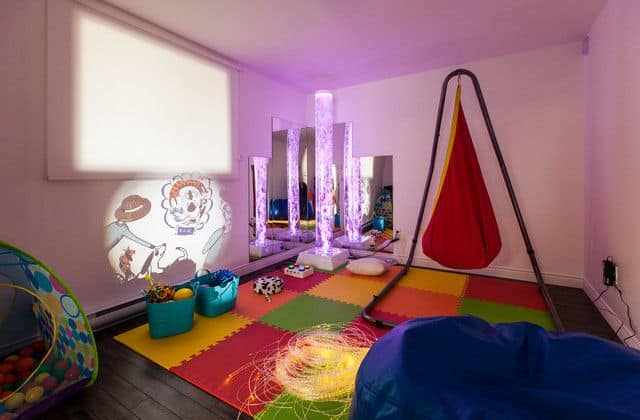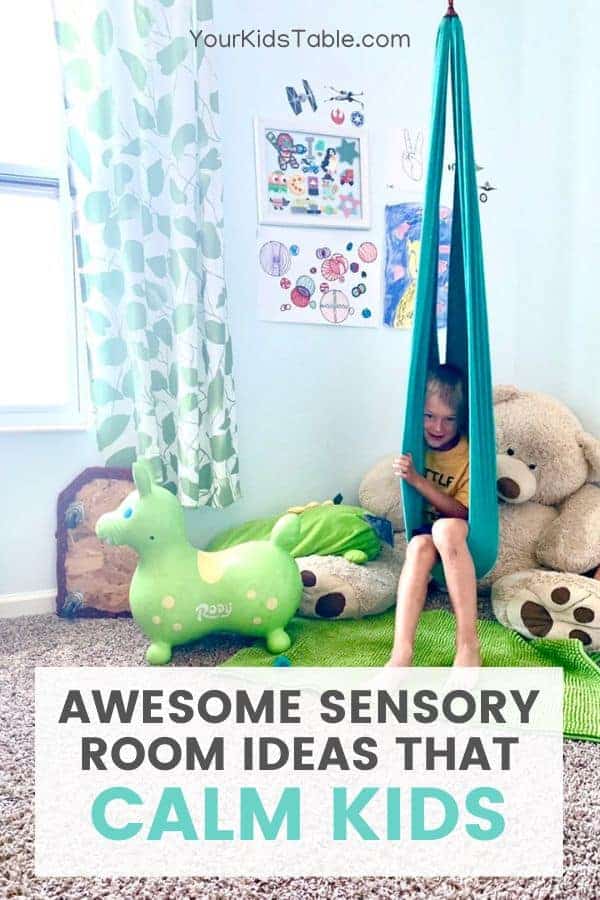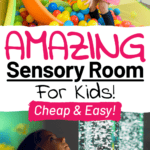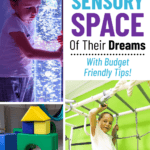Get inspired with these easy and affordable sensory room ideas for kids! And, learn step by step DIY and create your own sensory room on a budget. Affiliate links used below.
Affiliate links used below. See our full disclosure.
I was in grad school when I walked into a sensory room for the first time. It was a small dark room with all sorts of softly lit toys and projectors. Melodic music was playing and a child was calmly rocking in a swing in a corner of the room.
As my eyes adjusted to the light, I noticed a huge textured pillow, sensory bins, and vibrating toys kids could hold and wrap around their bodies.
It was almost magical. Like I had just stepped into a hidden world.
Sensory rooms are a powerful tool to regulate and calm any kid. They are helpful for kids with sensory processing disorder (SPD), Autism Spectrum Disorder (ASD), Attention Deficit Hyperactivity Disorder (ADHD), and those without any diagnosis but just needing some sensory support whether they are sensory seekers, avoiders, or have low registration of sensory input.
And, there are so many ways to create a sensory room. They can be elaborate or simple. Expensive or totally budget friendly. You can have a separate room or use the corner of your living room!
Whether you have a kid with sensory needs or just want to encourage strong development with your child, you’re in the right place.
You’ll learn exactly what a sensory room is, how to create one on a budget, and get inspired with some sensory room ideas!
What is a Sensory Room?
A sensory room is a space set apart to stimulate or regulate a child’s (or adult’s) senses. A sensory room can be dark and relaxing, bright and engaging, or a combination of both.
Sensory rooms are commonly found in elementary and special needs schools, as well as occupational therapy clinics and sometimes children’s museums. Occupational therapists and teachers use them frequently to help calm kids down with regulating sensory input.
Public sensory rooms are often elaborate and contain lots of expensive sensory tools and equipment, but you can set one up in your home on a budget!
Does Your Child Need a Sensory Room?
Sensory rooms are fun and many children will enjoy them for the rich sensory experience they provide. If you have the space and want to give your child a load of sensory play on a regular basis, then a sensory room makes sense!
Most often though, sensory rooms are created in a home for children that have daily sensory needs like:
- Very active, climbs furniture and runs around constantly
- Easily overstimulated by lights, noise, or people
- Sensory issues with tactile input such as avoidant of clothing texture to skin
- Difficulty managing emotions, poor regulation in response to environment
If you’re using a sensory diet or sensory activities on a regular basis, then having a dedicated space for some key sensory toys and tools could be really beneficial.
Just remember a sensory room can be simple and doesn’t have to involve lots of high ticket items. It can also be inside of a closet or section of a larger room.
You can even turn your child’s space into a sensory bedroom to meet their unique needs. The most important thing is that you’re finding ways to give your child their own sensory space.
Awesome Sensory Room Ideas
There are so many different types of sensory rooms and the best one for your child will be based on their sensory needs. Meaning, if your child loves movement, you’ll want to include something they can move on.
If your child needs a place to retreat, you may want to create a darker space with some soft lights.
You’ll add a few other activities so when they’re in the space, they have some options to choose from. The benefits of sensory rooms are really meant to target exactly what input your child needs.
As you scroll through the images below, don’t focus on trying to recreate them specifically, but look for what elements your child will likely respond well to.
This collage below is from Calm the Chaos and Steam Powered Family. See the soft lighting all over the room? It’s dark, but lots of interactive lights that immediately exude calm. There’s also lounging pillows, cushions, and bean bags. Plus, tons of textures to feel.
Check out that DIY texture wall, pretty cool!
This next sensory room is simple with a cozy corner, optic lights, different textured pillows, mirror, and gel pads to step on!
Photo from Fun and Function
You can also go the more interactive route with all sorts of visual, touch, and sound stimulation like this sensory room on a budget from Parenting Special Needs
If your kid is a big time sensory seeker you might want your sensory space to be heavy on movement so they’re getting lots of vestibular and heavy work/proprioceptive input. Use rugs and mats to cover concrete, tile, or wooden floors.
Photo credit to Fun Factory Sensory Gym
Here’s another sensory room with a modern design that can share a space with a family room. The focus here is on hanging and climbing.
Photo Credit to Pinterest
Another option is to combine your sensory room with your playroom. Chaos and Rainbows on Instagram did just that, for a fun engaging space, with a lot of visual stimulation. Some kids will benefit from having less on the walls if they tend to get overstimulated. But, it’s great inspiration…
View this post on Instagram
And, then we have the sensory room in Gatwick Airport in the UK. They created a sensory room for children with special needs to get away from the over-stimulation of an airport. They have interactive light up walls, tunnels, tubes, and soft lighting all around.
This last room has a great balance of different types of sensory stimulation. It’s also divided into separate areas. In one corner, they’ve hung a swing, in another a ball pit. There is also some fiber optic string, large crash pad cushion, a vibrating seat (see the cow print pillow), mirrors, large bubble lamp (in front of mirror), projector, and bins of sensory toys and fidgets.
Photo from Pinterest
Sensory Room Ideas on a Budget
When you start looking at all the cool sensory toys, it’s easy to get carried away, but you can often DIY some items for your sensory room, or at least think out of the box. Here’s 3 easy steps to start creating your own sensory room:
Step #1: Identify what your child’s sensory needs are
That’s a big question for sure. Our free sensory workshop can definitely help fill in the blanks, but think about what your child loves to do AND what they avoid.
For example, if you notice your child always spinning, rocking on the porch swing, and touching everything around them, then that’s a big clue.
You can conclude that a sensory swing and some textured toys or a sensory bin are a good fit for your child’s needs. Check out our sensory swing guide to pick a swing that will benefit your child.
Or, you may notice your child avoids lights, sounds, or different textures, then you’ll want to start thinking about how to make the room quiet, peaceful, and have low light. Get the idea?
Step #2: Brainstorm Sensory Tools and Toys
Write down 3-5 sensory tools you could use for a small sensory room space and up to 15-20 for a larger sensory space. Consider focusing on 1-2 higher ticket items, if your budget allows. Use the pictures above to inspire you or pull some ideas from this list:
Under 25$
- Sensory bin
- Vibrating massage bug
- Fidget toys
- Lava lamp
- Scooter board (check out this DIY version)
- Yoga ball
- Sensory bottles (DIY version here)
- Peanut ball
- Lava lamp
- Weighted blanket
- Bubble tubes
- Noise cancelling headphones
- Chewy tubes
- Portable speaker
Under 50$
- Rock wall hand holds
- Textured pillows
- Large pillows or crash pads
- Vibrating cushion
- Sensory light projector
- Body sock
- Small pop up tent
- Bean bag chair
- Wobble stool
Under 150$
- Gym mat or foam puzzle floor
- Swing
- Glowing bubble tube lights
- Fiber optic curtain light
- Monkey bars
- Ball pit and balls
- Gel pad tiles
- Rodi bouncer
- Trampoline
- Sensory pea pod boat
- Black out tent
Step #3: Create a Unique Space for Your Kid’s Sensory Needs
Now it’s time to put it all into action. Look at your list and get the supplies or tools you need. Get your space ready by moving other furniture if needed. Try to set up different areas within the space. For instance, put fidget or textured toys in a bin.
Place cushions in front of the swing and hang the swing away from the other sensory toys.
This creates different zones for your child to explore without becoming over stimulated.
What are you most excited to try in your sensory room? Tell me in the comments below, I’d love to hear from you!
Learn More About Your Child’s Sensory Needs
Kids can have all sorts of sensory needs that range from running non stop to refusing to go to birthday parties. Sometimes sensory needs can make kids seem bad, overly sensitive, or weird.
Getting a handle on what your kids sensory needs are, is important because then you can start figuring out how to help them, like when you create their sensory room.
If you aren’t sure what your child’s sensory needs are, or want to make sure you aren’t missing any then grab our free 21 Sensory Red Flags checklist!
Click here to grab the list now!
More on Sensory Rooms for Kids
13 Easy Sensory Strategies for the Classroom
3 Ways to Figure Out if Your Kid Has Sensory Over or Under Processing
7 Awesome Sensory Activities Using a Yoga Ball
5 Ways to Use a Scooter Board for Sensory Input
Did You Pin This?
Alisha Grogan is a licensed occupational therapist and founder of Your Kid’s Table. She has over 19 years experience with expertise in sensory processing and feeding development in babies, toddlers, and children. Alisha also has 3 boys of her own at home. Learn more about her here.
